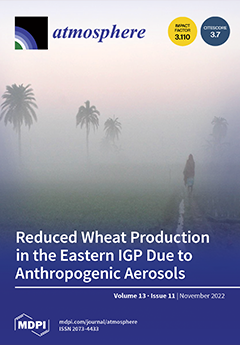The concentrations of total suspended particles (TSPs) on four buildings near a steel plant’s bulk material storage site for iron ore, coal, limestone, and sinter were evaluated for summer and winter, where the concentrations were 58 (17–55) μg m
−3 and 125 (108–155) μg m
−3, respectively. A multivariate regression analysis of meteorological parameters with TSP concentrations indicates that temperature, wind speed, and frequency of rainfall are potential predictors of TSP concentrations, where the respective
p values for the model are
p = 0.005,
p = 0.049, and
p = 0.046. The strong correlation between usual co-pollutants, CO, NO
2, and NO
X with TSP concentrations, as indicated by the Pearson correlation values of 0.87, 0.86, and 0.77, respectively, implies substantial pollution from mobile sources. The weak correlation of SO
2 with TSP concentrations rules out a significant pollution contribution from power plants. The speciation of TSPs in winter showed the percentage proportions of water-soluble ions, metal elements, and carbon content in winter as 60%, 15%, and 25%, while in summer, they were 68%, 14%, and 18%, respectively. Water-soluble ions were the most significant composition for both seasons, where the predominant species in summer and winter are SO
42− and NO
3−, respectively. In the TSP metal elements profile, the proportion of natural origin ones exceeded those from anthropogenic sources. The health risk assessment indicates a significant cancer risk posed by chromium, while that posed by other metal elements including Co, Ni, As, and Pb are insignificant. Additionally, all metal elements’ chronic daily occupational exposure levels were below the reference doses except for Cu and Zn. Insights from this investigation can inform decisions on the design of the TSP-capturing mechanism. Specifically, water sprays to capture the water-soluble portion would substantially reduce the amplified concentrations of TSPs, especially in winter.
Full article





